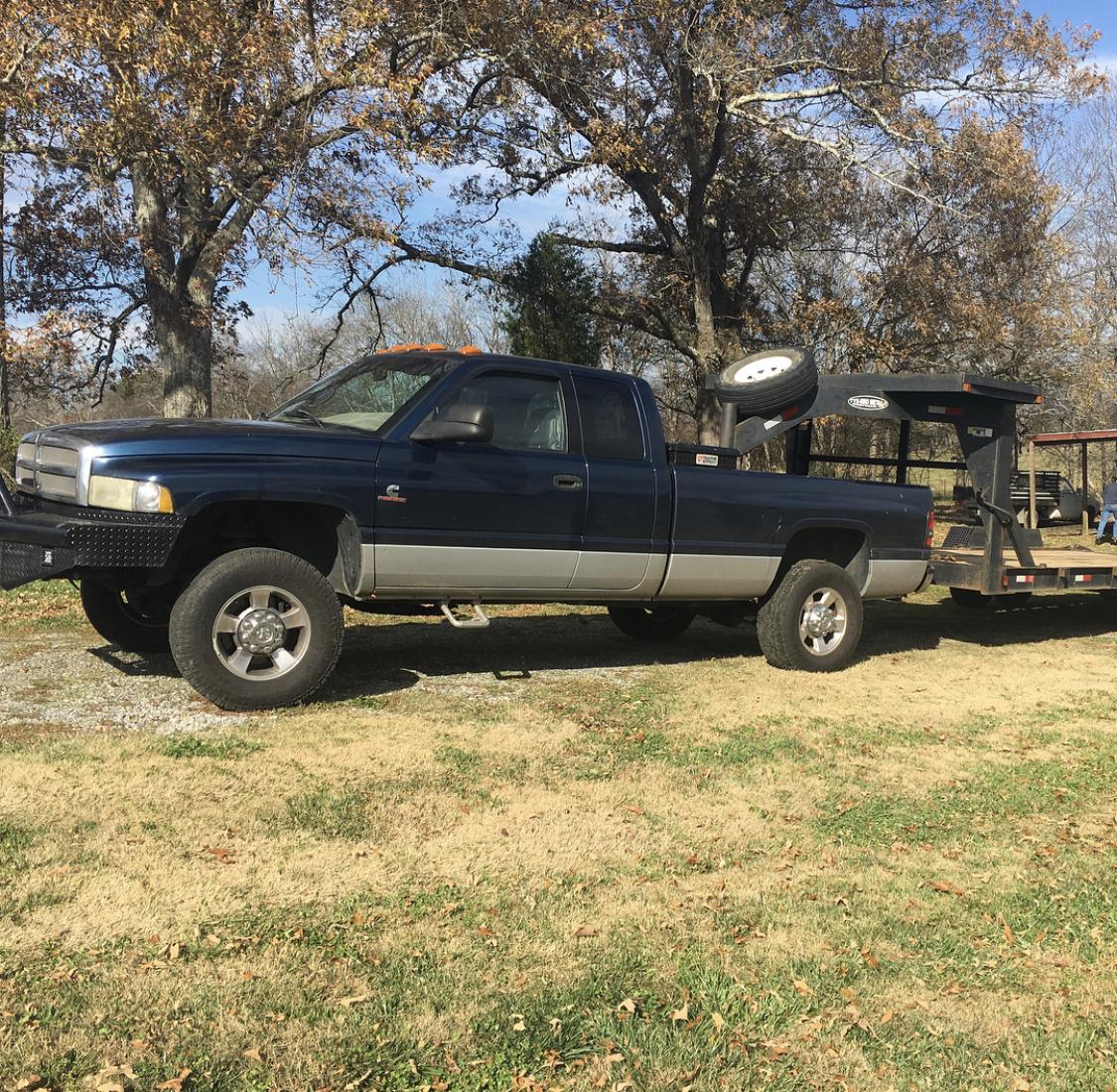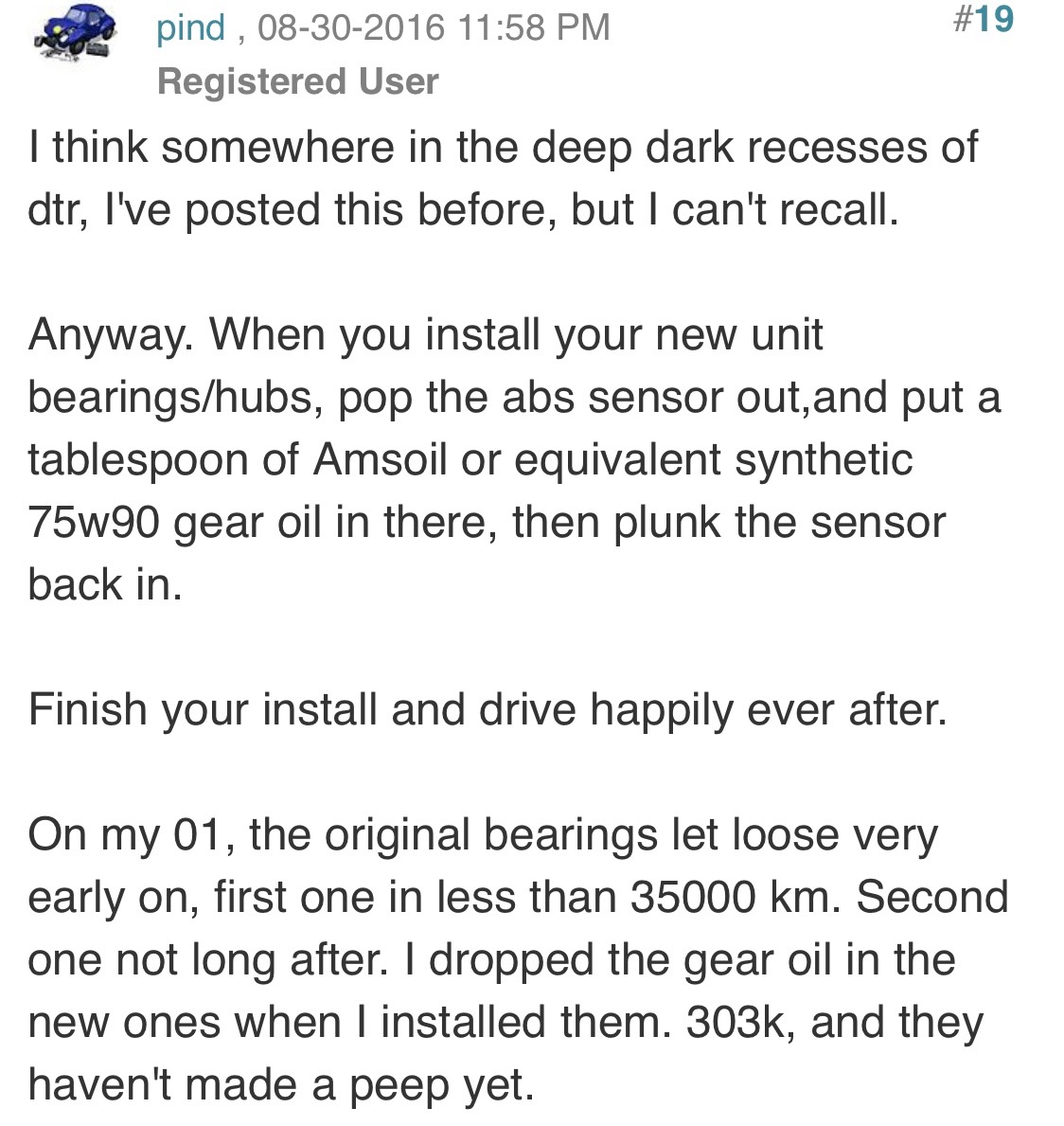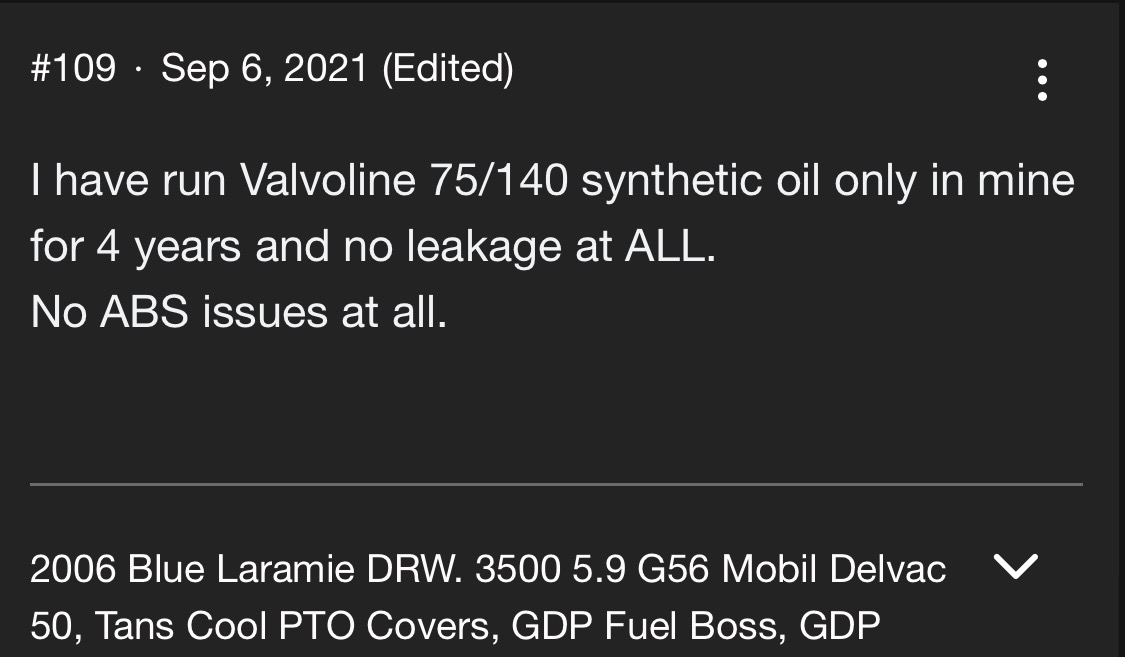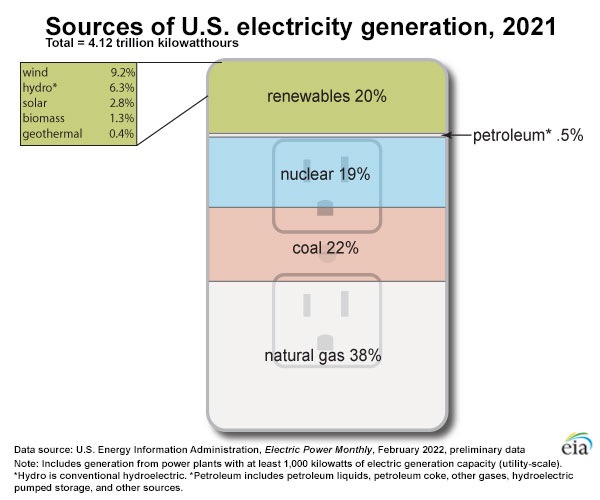
Everything posted by Andyba20
-
Diesel Price
It’s been fluctuating by .60 to .70 cents from day to day and even station to station the same day in East Tennessee. Oddly enough, the cheapest diesel has been at the Mobil stations, which are few here.
-
Banks high flow intake elbow and OEM grid heater replacement
Does it feel like the draw is the same, just less output? Or less draw/less output?
-
Banks high flow intake elbow and OEM grid heater replacement
I think he makes quality stuff, just hypes and overmarkets the hell out of it…but that works with the masses. I’m more of an under promise and over deliver type of guy.
-
Banks high flow intake elbow and OEM grid heater replacement
How did the bolt look? Fine? Hanging by a thread? Degraded but structurally intact?
-
Diesel Price
$5.03 in Tennessee yesterday
-
Consensus-Greasing Wheel Bearings (ABS Port)
Longtime Grateful Dead roadie exposes “the big lie” perpetuated by @Mopar1973Man and others.
-
Consensus-Greasing Wheel Bearings (ABS Port)
Greased the front left bearing tonight while replacing the abs sensor, took it out for a spin, bearing immediately exploded. Sent me and the truck through a nativity scene in my neighbor’s yard. Nah, it was easy and went well. Got about 10 pumps in before I felt a little more resistance and stopped. Napa bearings with 40K. I’m going to do the other side tomorrow with a tablespoon of gear oil and see which one goes further. 40 mile trip at 70mph, no abs light.
-
Consensus-Greasing Wheel Bearings (ABS Port)
Here are a few of the threads I saw discussing the gear oil options. I think the idea is either 1.) the thinner gear oil gets in the inner part of the bearing easier/quicker, or 2.) gear oil cools better?
-
Consensus-Greasing Wheel Bearings (ABS Port)
I’ll likely just use grease too, just wanted to add that as part of the record. Also, here is a picture of an assembly someone cut open, shows access to the bearings.
-
Consensus-Greasing Wheel Bearings (ABS Port)
From what I gather it’s a 75/25 mixture. So 75% bearing grease and 25% gear oil.
-
Inconvenience of EVs
If I adjust to assume EV’s are 3X more efficient per KWH then the math changes to a combined total of 6.54 trillion kwh’s needed. That puts renewables meeting 12.5%, but it also would eliminate 2.8 Billion barrels of oil from the overall demand. again these numbers don’t account for certain variables, and doesn’t paint the overall picture of CO2 emissions as we still have to calculate battery manufacturing, charging station infrastructure, grid infrastructure, ect… So considering costs, CO2, function, national security, and economic security, is the juice worth the squeeze? Aside from those considerations, I personally want more conclusive evidence on human activities contribution to climate change. Some call that being a climate denier, I call it truth seeking.
-
Consensus-Greasing Wheel Bearings (ABS Port)
Ok so what kind of grease do they come packed with? The answer would be to use the same stuff…no different than using the correct engine oil or gear oil or brake fluid. Mike-were they the original bearings? How many miles? Did the owner add grease through the ABS hole? If so, why, bc the bearing making noise or getting hot?
-
Inconvenience of EVs
If we convert the total number of gallons of diesel/gas consumed in the US last year to barrels of oil we get 4.32 billion. Each barrel contains 1,700kwh. The math on that comes to 7.344 trillion Kwh’s. The graph below shows the total kwh’s consumed last year in the US at 4.12 Trillion. Only 20% of that was renewable, so .824 Trillion kwh’s. If we convert 100% to EV’s that puts the total Kwh needed at 11.46 Trillion. Currently renewables could only meet 7% of the demand needed.
-
Consensus-Greasing Wheel Bearings (ABS Port)
2 questions. There’s grease in them already, so wouldn’t that happen either way? And would that explain why some are doing the grease/gear oil mix? To mitigate wear?
-
Inconvenience of EVs
So I just went ahead and used the Motor Trend tow test and split the difference on weight/mileage and did 225m/135kwh: 1.66kwH per mile. To match the Cummins distance it’s 945/1.66kwh: which would mean a 569.2kwh battery. 569.2 X 12.9 would be a 7,343 lb battery. im using this article as a reference point for determining CO2: https://climate.mit.edu/ask-mit/how-much-co2-emitted-manufacturing-batteries so if the 80KwH Tesla model 3 battery makes an average of 9 metric tons of CO2 to manufacture, and each metric ton is the equivalent of driving a regular ice vehicle 2,500 miles, then before it’s rolled off the lot it’s produced the equivalent of driving a ice vehicle 22,500 miles. A RiviAn battery large enough to meet match the range of Mikes truck would need over 7 times the KwH in the Tesla battery, which would be equal to 157,500 ice miles before it’s even rolled off the lot. Math comes to 1,319 lbs CO2 (RiviAn) and 770 lbs CO2 for the Cummins. Again-based on coal generated electric, if I adjust across averages for generating electricity it would be .885 X 569=503 lbs CO2 for the RiviAn. again, I’m likely oversimplifying some of this, and there are so many variables to consider, including the sources of information. But it’s something worth watching and adding new data and information to as it comes available. I’d still buy a Tesla just bc I think they’re cool and they’re fast. If it was solely based on practicality I’d probably go for a hybrid. The range/battery problem needs to be solved, someone will have to defy certain properties of nature to do it. Last thing, cost. You can see as the EV range increases the weight increases due to needing additional battery capacity. I used the national average cost of electricity. 135Kwh X .18 cents= $24.30 (8 cents per mile) 11 gal diesel X $6 =$66 (22 cents per miles) when adjusted for mikes range of 945 miles 569kwh X .18 cents= $102.42 (10.8 cents per mile) 35 gal diesel X $6=$210 (22 cents per mile) So as capacity is increased for range, the battery weight increases and begins to increase the cost per mile, while the diesel remains the same (duh). Curious to see how the Tesla semi’s that Elon just rolled out will handle this.
-
Inconvenience of EVs
This is the most math I’ve done since like 2001, and I’m not even sure what point I’m making other than to try to determine efficiency’s, and we’re comparing different technologies, but it matters bc one is trying to replace the other. So let me come at it this way… best case, Mikes truck can go 945 miles on a fuel 35gal tank. No towing, just base weight, efficiency tuned in. if the RiviAn wants to match that same distance without recharging it would need a battery capacity of 429.5 kwh’s based on 2.2 miles per KWh. Earlier that math showed the RiviAn battery weight at 12.9lbs per KWH. So 12.9X429.5 would mean a 5,541 lb battery. The RiviAn base weight is 7,134 lb. Add that to 5,541 lbs and subtract 1,750 so we don’t count the original batter twice and you get 10,925 lbs. So that’s nearly 5,000 pounds over the base weight we calculated from, and the additional weight requires a lot of extra power to move. So what we need to figure out is how to adjust the mile per kWh at 10,925 lbs which will ultimate require more capacity on the truck and more weight. Kwh’s on an EV come at a price, and that price is weight. I’m trying to figure out a formula for it…and my brain is shot too.
-
Inconvenience of EVs
I think it we calculate it that way we have to adjust Mikes truck to match 90 miles. So 90/15mpg is 6 gallons. 6x22lbs co2 =132lbs using the KwH capacity from the RiviAn it’s still using 135Kwh per charge, just going less miles. So the RiviAn would still be using 151lbs co2 just to go 90 miles.
-
Inconvenience of EVs
Definitely ton of variables to consider. What I’m also wanting to figure out is how do we calculate power consumption increases when towing with an EV? This has good info. https://www.motortrend.com/features/how-far-can-you-tow-with-electric-truck-range/ So just like we have to consider efficiency lost in ICE vehicles, don’t we have to consider power consumption increases on EV’s when adding weight (towing)? Meaning if the RiviAn truly were to meet the range of the Cummins and really did require a 16,000 lb battery to do it, how much would that weight effect power consumption? Because that would mean more charging, more charging means more electric consumption which means more carbon footprint. we need a formula to figure miles per KWH adjusted for weight. and is added weight power consumption increases on EV’s the equivalent of heat/power loss inefficiencies in ICE vehicles? Maybe that won’t matter someday when/if the electricity we consume is zero carbon, but it will matter in cost of KWH per mile.
-
Inconvenience of EVs
Some interesting numbers to mess around with: Comparing a 2nd gen Cummins to a Rivian Truck. None of this is adjusted for efficiencies lost in a Diesel engine, just a baseline to start some math. RiviAn Battery holds 135KwH, weighs 1,750lbs, and can travel a distance of 300 miles peak at full charge. Mopar1973mans Quadzilla tuned Cummins holds 35 gallons of diesel fuel, fuel tank weighs 245lbs, and at peak tune gets 945 miles per tank (27mpgx35) 1 gallon diesel contains 37.1 KwH Full tank holds 1,298.5kwh (37.1X35 gal) 245lbs/1,298.5kwh’s=.188 lbs per KwH 945 miles/1,298.5kwh= .727 miles/KWH RiviAn battery 1,750lbs/135kwh= 12.96lbs per Kwh 300 miles/135kwh= 2.2 miles/KwH 12.96 X 1,298.5kwh (total held in diesel tank)= 16,832.4 lbs RiviAn would need a 16,832lb battery to hold the same kwh’s as the diesel tank at 245lbs which gives a density of: 68.7X 2.2 miles/.727miles=3.05 So the RiviAn is getting 3.05X better mileage per kwh than the diesel. 300 miles/27mpg=11.11 gallons 11.11x37.1= 412kwh So for the Cummins to travel the same distance (300 miles) would take 11.11 gallons of diesel and 412KwH’s which again lands us at the RiviAn being 3.05X more efficient per KWH. Of course this only highlights what we already know, which is the range and convenience/speed to (refuel) a diesel is superior to current EV battery capabilities and so the efficiencies don’t matter (yet). Next is to figure out the CO2 emmisons, feel free to help with math. I’ll post more when I gather all the info, but here’s what I have so far. Need to adjust for efficiencies (90% RiviAn and ??? 25% diesel?) Also, need to know the true carbon footprint to mine/manufacture EV batteries, including considerations for volume of water to make them. Also need to adjust for EV power consumption demands when towing. Using EPA.gov info (valid to question accuracy) A barrel of oil contains 1,700 KwH’s of energy 1,700 KwH/37.1 KwH =45.8 gallons of diesel in barrel of oil. 1lb coal=2.07lbs c02 1 gallon diesel=22lbs co2 1.12lbs coal=1 kwh 150lbs coal to create 135kwh electricity 310.5 lbs co2 per riviN charge =300 miles 11.11 gallons diesel to reach 300 miles 11.11 X 22lbs CO2 =244.4 lbs CO2 This is as far as I’ve gotten, and not all electricity is made with Coal, so this will vary regionally.
-
Consensus-Greasing Wheel Bearings (ABS Port)
At this point I’m about ready to say it’s negligent if you don’t do this.
-
Inconvenience of EVs
We were born 150 years too late, back in the day Americans could do stuff like this…you try that today and the federal government would own you forever…no good deed right? Gotta start resisting the overreach. Heck, the EPA is even rolling out standards for wood burning stoves. Check this out from the UK…they WILL NEVER stop… {Research published in the last year has shown wood burning in homes is the single biggest source of small particle air pollution in the UK, producing three times more than road traffic, despite just 8% of the population using wood burners. Even new wood burning stoves meeting the “ecodesign” standard still emit 750 times more tiny particle pollution than a modern HGV truck. Wood burners also triple the level of harmful pollution inside homes and should be sold with a health warning, according to scientists. “You basically stop burning wood. That’s the bottom line”}
-
No low beams
Does your sport system with upgraded harness use dual filament bulbs for low beam? I believe the 9007 are dual filament so you’d still have the low bulbs working with high beams engaged if just the low beam filament went out. If it’s not that, does your kit power the bulbs from the battery (off a relay?) I’d check that and make sure your connections are good, and check the connectors at the relays. I have the Daniel Stern kit, that’s where I’d start, assuming yours is similar.
-
Inconvenience of EVs
You still have to trace the source of the electricity, if it’s generated with fossil fuel then aren't we just moving a lot of the inefficiencies upstream? I read an article a while back and can’t remember exactly, but it was talking about the density of liquid fuel vs batteries. The liquid fuel is like 50 times the density of current EV batteries. So our trucks would need a 12,000 pound battery (is that right?) to travel the same distance. Assuming EV motors are more efficient I guess changes that, but I’m not smart enough to figure out all the variables. Bottom line, the article basically has everyone agreeing that battery tech won’t catch up and match petroleum for another 20 years. Which leads us back to what we agree on which is EV’s are great for local driving, running into town. I don’t think they save you any money, I think they’ll cost more (purchase price, electricity rate increases, tax increases to pay for grid) and I don’t think they’ll help the environment, not for a long time. The % raise due to human activity matters to me bc I want to know that we are working to solve the right problem. Otherwise, the massive global push to save earth through clean energy is akin to masks for Covid.
-
Inconvenience of EVs
That is exactly what I do. I think they choose a narrative that helps them meet their agenda and then the media, academia, and global think tanks drill it into the public conscience. I’m a truth seeker, so both sides hate me. For example, I can see data that shows the global temperature has increased 1.8 degrees F since 1880, with the yearly increase rate doubling since 1981. But what I want to know is what % of that 1.8 degrees can be attributed to human activity…that’s an important thing to know if you’re going to change the entire worlds energy infrastructure based on climate change. Then I get even more suspicious when I see the messaging change to help move the narrative along. Global warming to Climate Change to Clean Air Act…punks.
-
Inconvenience of EVs
That’s the other hard part, I try to do my own research instead of relying on the news, but I don’t even trust studies, reports, government statistics anymore. Like you said, money has corrupted everything (including and especially climate scientists).









